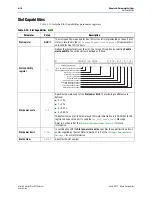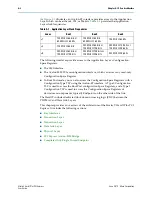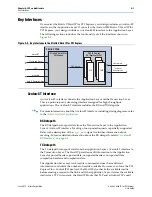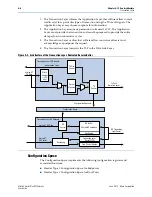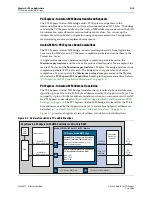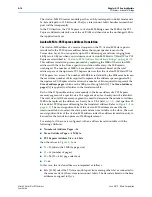
Chapter 5: IP Core Architecture
5–5
Transaction Layer
June 2012
Altera Corporation
Stratix V Hard IP for PCI Express
Interrupts
The Stratix V Hard IP for PCI Express offers three interrupt mechanisms:
■
Message Signaled Interrupts (MSI)— MSI uses the Transaction Layer's
request-acknowledge handshaking protocol to implement interrupts. The MSI
Capability structure is stored in the Configuration Space and is programmable
using Configuration Space accesses.
■
MSI-X—The Transaction Layer generates MSI-X messages which are single dword
memory writes. In contrast to the MSI capability structure, which contains all of
the control and status information for the interrupt vectors, the MSI-X Capability
structure points to an MSI-X table structure and MSI-X PBA structure which are
stored in memory.
■
Legacy interrupts—The
app_int_sts
input port controls legacy interrupt
generation. When
app_int_sts
is asserted, the Hard IP generates an
Assert_INT
<n>
message TLP.
For more detailed information about interrupts, refer to
.
PIPE
The PIPE interface implements the Intel-designed PIPE interface specification. You
can use this parallel interface to speed simulation; however, you cannot use the PIPE
interface in actual hardware. The Gen1 and Gen2 simulation models support pipe and
serial simulation. The Gen3 simulation model supports serial simulation only with
equalization bypassed.
Transaction Layer
The Transaction Layer is located between the Application Layer and the Data Link
Layer. It generates and receives Transaction Layer Packets.
illustrates the
Transaction Layer. The Transaction Layer includes three sub-blocks: the TX datapath,
the Configuration Space, and the RX datapath, which are shown in
.
Tracing a transaction through the RX datapath includes the following steps:
1. The Transaction Layer receives a TLP from the Data Link Layer.
2. The Configuration Space determines whether the TLP is well formed and directs
the packet based on traffic class (TC).
3. TLPs are stored in a specific part of the RX buffer depending on the type of
transaction (posted, non-posted, and completion).
4. The TLP FIFO block stores the address of the buffered TLP.
5. The receive reordering block reorders the queue of TLPs as needed, fetches the
address of the highest priority TLP from the TLP FIFO block, and initiates the
transfer of the TLP to the Application Layer.
6. When ECRC generation and forwarding are enabled, the Transaction Layer
forwards the ECRC dword to the Application Layer.
Tracing a transaction through the TX datapath involves the following steps:








